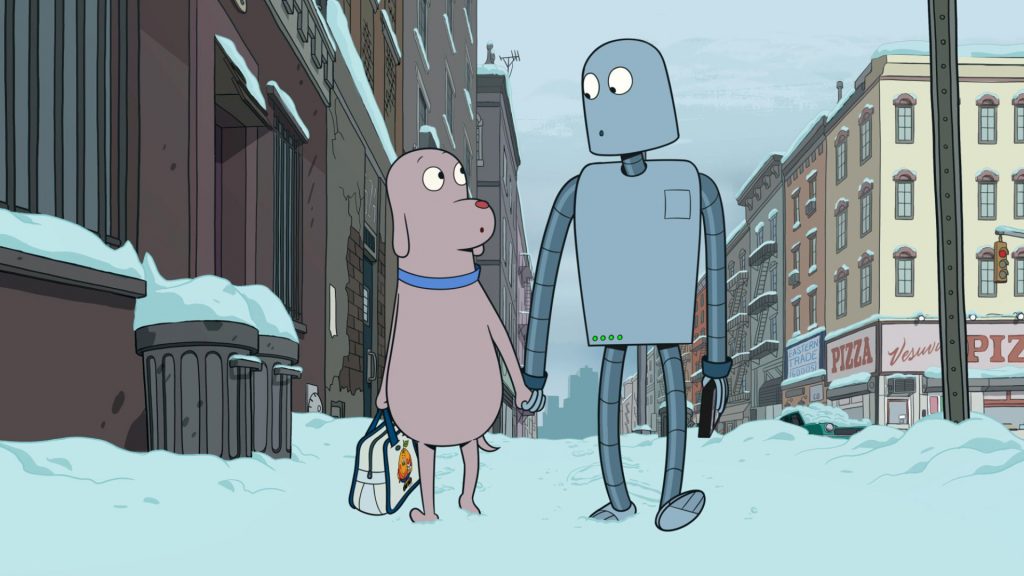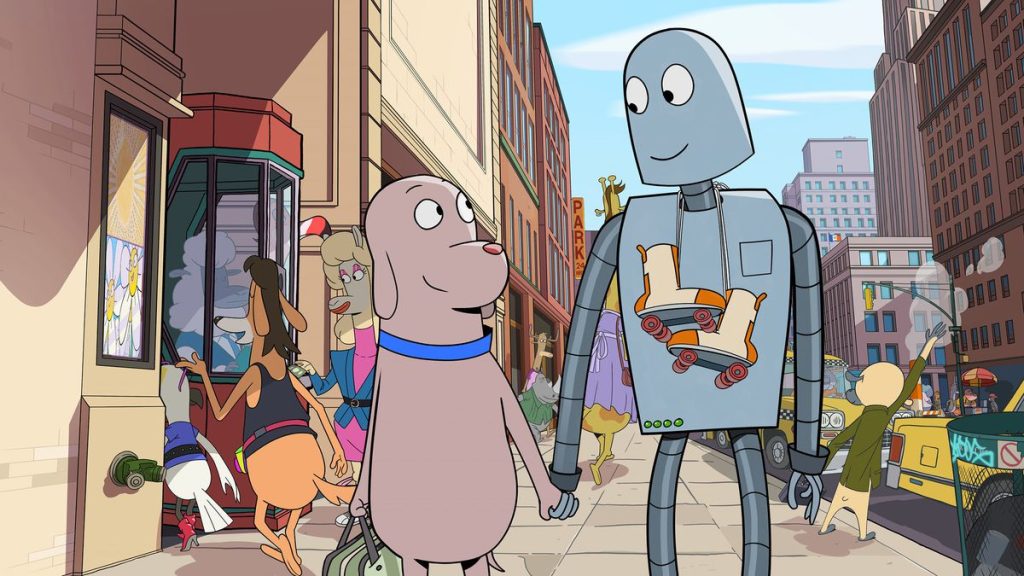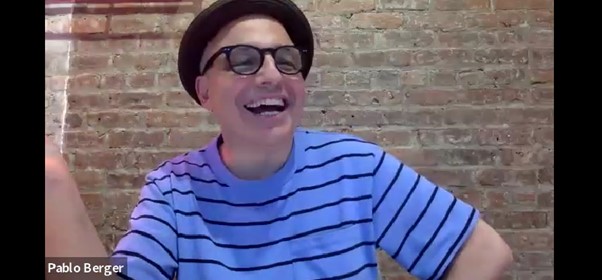We talked to Pablo Berger, director and screenwriter of "Robot Dreams"
Robot Dreams has become a sensation among both children and adults. The multi-award-winning film by Spanish director Pablo Berger has toured various prestigious festivals worldwide and has recently won the hearts of both Latin American audiences and critics with "Robot Dreams" which is set to premiere on June 1st in the United States.

ROBOT DREAMS: The Story
The animated film is set in New York City, where its protagonist, Dog, lives. Dog is tired and feels lonely in this big, bustling city. One day, a TV commercial changes Dog's life completely, as he learns he can buy a Robot friend. Dog eagerly awaits the arrival of the box, and when it finally arrives, he anxiously begins assembling the pieces of his long-awaited Robot friend. When the start-up sound finally fills the room, a friendship begins that will teach us many lessons and make us reflect on the various forms of love in life.
We had the pleasure of speaking with its director and screenwriter, Pablo Berger, who reviewed the creative process of making Robot Dreams, his learnings, and what this film has meant in his life.

THE INTERVIEW
Francisca: Hello Pablo, my name is Francisca from Spanglish Cinema Chile. How are you? And congratulations.
Pablo: Thank you. Thank you, Francisca. I love that you congratulated me, and I know that the movie has just been released in Chile.
Pablo, I know this movie is based on a graphic novel that has no dialogue, but I love hearing that part of your creative process is based on two concepts that I find very interesting: writing with images and animation not as a genre but as a medium. Tell us how these two merge in "Robot Dreams."
P: Well, the truth is that the first thing that attracted me to Sara Varon's graphic novel is that it had no dialogue.
I made a movie ten years ago called "Blancanieves," which also had no dialogue, and I was looking to repeat that experience. So, when I found Sara Varon's graphic novel, I realized it was my opportunity to make another movie without dialogue and focus on writing with images,which I call cinema puropure cinema. It's based on the silent film era when cinema was at its most original, a sensory experience. The dialogue didn't overshadow the image, and animation seemed like an added element, a challenge, a journey into the unknown. I like each movie to be different from the last, so I was very attracted to doing something I hadn't done before. I enjoy diving into new projects without knowing how they'll turn out, and that's an exciting part.
Definitely, and how did you navigate this? I love the contrast where Robot is seeing everything for the first time, from the innocence of a child, while Dog is a bit disenchanted with his daily life, somewhat lonely. How did you personally navigate these two poles within the film?
P: Well, it's true that when I faced this movie, I was a bit like Robot because everything was new to me ; I was discovering a world. But I like to say that "Robot Dreams" is possibly my most personal film of all the ones I've made, that i´ve done and I am Dog.. I am that lonely dog. I lived in New York for ten years; I found love in New York, had my heart broken, fell in love again, made friends, lost friends, changed cities, and the movie talks a lot about that—loss, mourning, and memory to overcome the loss. These are universal themes, and experiences I've lived, but I think all viewers from all societies and countries around the world have had similar experiences. These are universal feelings.
Definitely, and I wanted to talk to you about a particular scene that has become memorable: that cathartic dance between Dog and Robot, and your choice of such a particular song, "September" by Earth, Wind & Fire. It's beautiful because you chose a song from the '70s that is now understood by a new generation not as Earth, Wind & Fire's song but as Dog and Robot's song. How do you feel about giving new meaning to a song that is already part of popular culture with something so beautiful?
P: Yes, I love what you're saying. It's true. It's a very special song. It's Robot and Dog's song.As you know, it appears many times in the movie in its original Fire format, as a piano version, or whistled in many versions. Curiously, the song's lyrics touch on the film's theme. The lyrics start with "Do you remember the twenty-first night of September?" Memory. "Do you remember?" That's an important part of the movie. It makes me very happy now that the movie has become popular worldwide, that people are discovering "September" through the film, and how a young audience, who didn't know the song, has added it to their playlists. The song is magical because for some unknown reason, which I believe music can't be explained, only felt, it doesn't tire you. I've listened to "September" a million times for obvious reasons, making a movie where it plays non-stop, and I could still hit play, start dancing, and humming. It's a song like the great classics, timeless and eternal.
Yes, beautiful, and it's wonderful to see new generations with the spirit of Robot and Dog. We talked a bit about New York, but I'm very interested in how you extended it as another protagonist in the story. When you introduce East Village, different music plays, reflecting the city's multiculturalism. So, tell me a bit about how you envisioned New York City as another protagonist.
P: Without a doubt, I think that was one of the major changes. Perhaps the graphic novel's protagonists were only the little robots, but in the film New York City is also a protagonist, something that wasn't in Sara Varon's novel.
I lived in New York for ten years, East Village, where most of the movie is set. As you mentioned, a key part of New York is its multiculturalism. It was the most striking thing for me when I arrived in New York: the diversity, different races, different music, different types of restaurants, a very tolerant city. That had to be reflected in the city with different animal races. That's why the movie features animals from five continents. Music was also important as a representation of each culture. You can hear Latin music, punk rock, hip hop, or street music like the bucket drumming octopus in the subway during a walk through the streets of East Village. New York is a fascinating city where music is another protagonist.
Pablo, tell us about your experience from Cannes, through the Goya nomination, the multi-award-winning film, and being with a very important label in recent years, Neón. Neón has become a wonderful quality label.
P: We're in Neón's offices right now.
Wonderful. They just won Cannes with Anora too. It's a quality label. I want to know how you feel about being part of that family and how the experience has been from Cannes 2023 until now with Neón.
P: It's been a wonderful journey, a rollercoaster, without a doubt. As you mentioned, it started in Cannes, in the official selection of Cannes, and we've been through hundreds of festivals, and dozens of awards. And releasing in the United States with Neón is indeed wonderful. Neón, as you know, carefully selects films. They have released five consecutive Palme d'Or winners in the United States, including the latest Anora, and they take great care of their film releases. I feel happy, and it's a great introduction to the United States, which is important because it's a tough market.
We premiere this Friday first in New York with what they call a platform release. We premiere first in New York, and next week in Los Angeles, New York. The following week in five or ten cities, and then all over the United States. We're all very excited. I just read the New York Times review, which is super positive, and I was a bit nervous about it, but now I'm more relaxed. Everything looks very good, and we hope that many people will go to see "Robot Dreams" in New York theaters this Friday.
To wrap up, what are your hopes? We've seen a bit of what happened in Latin America, and the phenomenon it became. What are your hopes for now that it's being released in the United States?
P: I want to think that what happened in Latin America will also happen in the United States and Canada, where it will also be released. Neighboring countries share certain sensitivities. Neón is betting on a film that will grow little by little, and I believe that happened in Latin America too. It's a movie that has grown gradually and has become a phenomenon. You know what happened in Mexico, Colombia, and Chile. It's wonderful because, as a director, I want to reach the largest possible audience. That's what makes me very happy: more people watching it. I also think animation allows that. Animated films don't have an expiration date. If they resonate with the audience, they stay in the cultural wardrobe. I'd like to think that "Robot Dreams" is a movie that stays in the cultural wardrobe and that future generations can also enjoy the film.
Definitely, and it transcends all kinds of generations too. In the discussions after watching the movie, you see children and adults talking from different perspectives. So, congratulations, Pablo.
P: Thank you, Francisca. I love your interpretation because it's true. Of all my films, I want to think this is the most transversal. It's a film for cinephiles, for people who want to watch an entertaining movie, and for children. So, I want to think it's a film that can bring together a very diverse audience, both in age and socioculturally. It's a film I want people to see in theaters. Thank you for supporting us, Francisca.
Aún puedes ver en cines “Mi Amigo Robot” en Latinoamérica y la entrevista completa acá:

